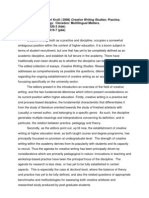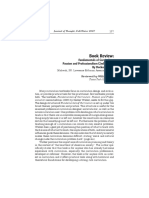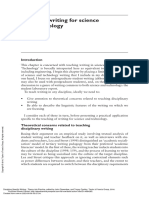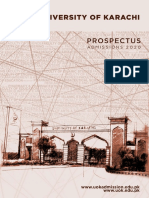Patchwork Text Winter
Uploaded by
Rajdai SaroopPatchwork Text Winter
Uploaded by
Rajdai SaroopCONTEXTUALISING THEPATCHWORKTEXT:ADDRESSINGPROBLEMSOF COURSEWORKASSESSMENTINHIGHEREDUCATION
RichardWinter,AngliaPolytechnicUniversity,Cambridge,UK
From ThePatchworkTextARadicalReassessmentofCourseworkAssignments (InnovationsinEducationandTeachingInternational,SpecialIssue) Vol.40,No.2,May2003 Summary TheproceduresofthePatchworkTextcourseworkassignmentformatareoutlined,anda generaljustificationoftheircurrenteducationalimportanceispresented.Theargument beginswithareviewofcurrentliteratureonassessmentprocessesinhighereducation, followedbyadiscussionofworkonthenatureof'academicliteracies'.ThePatchworkTextis comparedwithotherassignmentformats,includingtheportfolioand,especially,theessay. TheadvantagesofthePatchworktextovertheessayarearguedinthelightofgeneral theoriesofthenatureoflearning.
Introduction
ThePatchworkText,asaninnovatorycourseworkassignmentformat,isintendedasa practicalresponsetocurrentanxietiesaboutassessmentproblemsinhighereducation.The essenceofapatchworkisthatitconsistsofavarietyofsmallsections,eachofwhichis completeinitself,andthattheoverallunityofthesecomponentsections,althoughplannedin advance,isfinalisedretrospectively,whentheyarestitchedtogether.Thus,apatchwork textassignmentisonethatisgraduallyassembledduringthecourseofaphaseofteaching andconsistsofasequenceoffairlyshortpiecesofwriting,whicharedesignedtobeasvaried aspossibleandtocovertheeducationalobjectivesoftheteaching.Eachoftheseshortpieces ofwritingissharedwithinasmallgroupofstudentsaspartoftheteachinglearningprocess. Attheendofthecourse,studentsaddareflexivecommentarytotheshortpiecestheyhave alreadywritten,whichtheymayalso,iftheywish,reviseandedit.
Thisintroductorypaperoutlinestheeducationalimportanceoftheseapparently straightforwardprocedures,placing theminthecontextofeducationaltheoryandcurrent practice.WhilenotsuggestingthatthePatchworkTextisapanaceaforallourills,and recognisingthatbyamelioratingsomeproblemsweareexacerbatingothers,theargumentis, nevertheless,that theprinciplesofthePatchworkTextmakeasignificanttheoreticaland
practicalcontributiontoourunderstandingofassessmentpracticesinHigherEducation. Subsequentarticlesinthisvolumepresentreportsdescribingandevaluatingtheintroduction ofthepatchworktextinavarietyofdifferentacademicandprofessionaldisciplines, documentingbothitsstrengthsandtheproblemsencountered.
HigherEducationAssessmentasaProblemArea
Assessmentofstudentslearningisclearlyattheverycentreofuniversitiescorebusiness. Itisthefunctionthatuniversitiescarryoutonbehalfofsocietyitis,asitwere,theproduct wesell.Studentsattendourcoursesandtheyleaveuswithanofficiallydocumented judgementontheirwork,whichconstitutesbothanindividualisedevaluationandalsoa publicqualification.Universityassessmentsinformstudentssubsequentchoicesofwhatthey mightaspiretodo,andinformthedecisionsofotherpeople(e.g.potentialfutureemployers) astowhatstudentsshouldbelicensedtodo.Assessmentconvertslearningintocredentialsit isthepointofexchangeintheteachinglearningrelationship,theinterfacebetweentheexpert andthenovice.
Andyet,inspiteofthecentralimportanceofassessmentintheworkofuniversities, andthehundredsofyearsoverwhichuniversitieshavebeencarryingoutassessments,the currentliteraturedisplaysremarkablelevelsofdisquiet.PaulRamsden,inhisfrequently reprintedbook LearningtoTeachinHigherEducation openshischapteronassessmentby saying,Theassessmentofstudentsisaseriousandoftentragicenterprise(Ramsden,1992, p.181).AndDavidBoud,oneofthemostwidelyinfluentialwritersonthesubject,iseven moreemphatic:
Thereisprobablymorebadpracticeandignoranceofsignificantissuesintheareaof assessmentthaninanyotheraspectofhighereducation.Thiswouldnotbesobadifit werenotforthefactthattheeffectsofbadpracticearefarmorepotentthantheyarefor anyaspectofteaching.Studentscan,withdifficulty,escapefromtheeffectsofpoor teaching,theycannot(bydefinition,iftheywanttograduate)escapetheeffectsofpoor assessment. (Boud,1995,35)
SallyBrownbeginsherbook AssessmentMatters inHigherEducation bydescribingthe experienceofassessmentasanightmareformanyhighereducationstudents,andcontinues:
Theconventionalwaysbywhichwechoosehowtoassessourstudentsarejustnotgood enoughtoachievewhatwewant.(Brown,1999,4)
What,then,isthenatureofthetragedy,thecauseofthenightmare,thescopeofthe badpractice?Iwillbegintotrytothrowsomelightonthesequestionsbyexaminingtwoof thekeytermsfrequentlyusedtoframecurrentpresentationsofhighereducationassessment issues.
ConstructiveAlignmentDeepandSurfaceLearning
Rust(2002)beginshisrecentreviewofresearchonhighereducationassessmentbyreferring toBiggs'constructivealignmentmodel.Biggselaboratesthisasfollows:
ThecurriculumisstatedintheformofclearobjectivesTeachingmethodsarechosen thatarelikelytorealisethoseobjectivesFinally,theassessmenttasksaddressthe objectives. (Biggs,1999,26)
Rustpresentstheideaintermsofthreestages:
1. Identifyclearlearningoutcomes 2. Designappropriateassessmenttasksthatwilldirectlyassesswhethereachofthe learningoutcomeshasbeenmet. 3. Designappropriatelearningopportunitiesforthestudentstogetthemtoapointwhere they cansuccessfullyundertaketheassessmenttasks. (Rust,2002,148)
Whatseemssurprisingaboutallthisiswhyitshouldneedtobestatedatall.Certainlyone shouldnotunderestimatetheimportanceanddifficultyofthelongstandingdebateaboutthe natureofeducationalobjectivesandoutcomes,concerningwhatsortofdetailcanhelpfullybe specifiedinadvance.Butsomethingprofoundlyseriousseemstobewrongifatextwhose majorthemeisthatteachingisenhancedbyaligningobjectives,teachingmethodsand assessmenttasks'(Biggs,1999,p.xii)immediatelybecomes,accordingtothepublishera bestsellerandifanuptotheminutereviewofresearchneedstoarguethatlearning outcomes,assessmenttasksandlearningopportunitiesneedto bemutuallyappropriate.If weneedtobetoldthis,onemightsay,nowonderthewritersintheprevioussectionsee
currenthighereducationassessmentpracticesintermsofnightmaresandtragedy.Howcan weunderstandthis?Asafirststepinaddressingthequestion,letusexaminetheconceptsof deepandsurfacelearning,whicharesouniversallyusedincurrentdiscussionsofhigher educationprocesses.
DeepandSurfaceLearningisthetitleofthesecondsectionofRusts(2002)review.The conceptswerefirstformulatedmorethantwentyfiveyearsago(MartonandSaljo,1976),but theyarestillboththestartingpointandthepervasivethemeofthepopularbookbyProsser andTrigwell(1999,seep.3,pp.902,16970).Inasense,Biggs(1999)makesdeepand surfacelearningevenmorecentralinhisargument,usingitasakeyterminpresentinghis modelofaproperlyalignedteachingprocess,previouslymentioned.Whenwelookatthe detailoftheseargumentswecanseequiteclearlywhytheconceptsofdeepandsurface learningarestillsowidelyusedandalsowhytheyaresymptomaticofsuchprofoundanxiety concerningthestateofhighereducationteachingandassessment.Hereistheaccountgiven byProsserandTrigwell:
Themotivationassociatedwithadeepapproachtolearningistounderstandideasandseek meanings.Inadoptingthisapproachstudentshaveanintrinsicinterestinthetaskandan expectationofenjoymentincarryingitout.Theyadoptstrategiesthathelpsatisfytheir curiositysuchasmakingthetaskcoherentwiththeirownexperiencerelatingand distinguishingevidenceandargumentlookingforpatternsandunderlyingprinciples seeingthepartsofthetaskasmakingupthewholetheorisingaboutit Inadoptingasurfaceapproachtolearning,studentsseetasksasexternalimpositions Theyareinstrumentallyorpragmaticallymotivatedandseektomeetthedemandsofthe taskwithminimumeffort.Theyadoptstrategieswhichinclude:afocusonunrelatedparts ofthetaskseparatetreatmentofrelatedpartsafocusonwhatareseenasessentialsthe reproductionoftheessentialsasaccuratelyaspossibleandrotememorizinginformation forassessmentpurposesratherthanforunderstanding.Overalltheywouldappeartobe involvedinstudywithoutreflectiononpurpose (ProsserandTrigwell,1999,91)
Inotherwords,thetermsdeepandsurfacelearningarticulateasensethatthewhole educationalenterpriseisfrequentlyineffectiveatthemostbasiclevel.Alltoofrequentlyour teachingfailstoelicitmorethananattemptbystudentstoexploittheambiguitiesinour assessmentprocesses,toplaythesystem.Insteadofwhatanyonewouldmeanbyeducation, wearefacedbyacombinationofritualism,deceptionandcollusion.Biggsaccountshows evenmoreexplicitlythatdeeplearningsimplyrepresentsourbasicprofessionalaspirations
aseducators,andsurfacelearningmerelyformulatesoursenseoffrequentfailure, frustrationanddisappointment:
Thedeepapproacharisesfromafeltneedtoengagethetaskappropriatelyand meaningfully,sothestudenttriestousethemostappropriatecognitivestrategiesfor handlingitTheytrytofocusonunderlyingmeaningstudentshavepositivefeelings: interest,asenseofimportance,challenge,evenofexhilaration.Learningisapleasure. Thesurfaceapproacharisesfromanintentiontogetthetaskoutofthewaywithminimum trouble,whileappearingtomeetrequirements.Lowcognitive levelactivitiesareused, whenhigherlevelactivitiesarerequired.Asappliedtoacademiclearning,examples includerotelearningselectedcontentinsteadofunderstandingit,paddinganessay,listing pointsinsteadofaddressinganargument,quoting secondaryreferencesasiftheywere primaryonesthelistisendless. (Biggs,1999,1614)
Tosumupthissection,then,thecontinuedemphasisontheobviousinjunctionthat educationalobjectives,teachingmethodsandassessmentprocessesneedtobe alignedand onthethreatthattheeducationalprocessatitsmostbasiclevelmaybesubvertedbywhatis euphemisticallycalledsurfacelearningindicatesanawarenessofacontinuingproblemat theheartoftheworkofuniversities.Thisisnotanewawareness:HowardBeckerandhis colleaguesdocumentedandanalysedwithbeautifulprecisionfortyyearsagohowstudents typicallyplayedthesystemofhighereducation,intheirbooksBoysinWhite:Student CultureinMedicalSchool (1961)and MakingtheGrade:TheAcademicSideofCollegeLife (1968).Buttheseweresociologistsexternal,ironiccritiquesofourprofession,whereasnow ithasbecomeanessentialaspectofourprofessionalselfunderstandingandastartingpoint foraconcertedsearchforremedies.
ItisasacontributiontothissearchthatthePatchworkTextisproposed(without suggesting,ofcourse,thatitisacompletesolution).Butfirstweneedtoreviewotherrecent proposalsforremedyingtheinadequacyofhighereducationassessment,bothintermsof generalprinciplesandthespecificinnovatoryassessmentformatsthatareintendedtoembody them.Itisimportanttonote,therefore,thatthefollowingtwosectionsarenotintendedasa fullycomprehensivelistofrecentproposalsconcerninghighereducationassessmentrather,it selectsoutthosesuggestionswhichprovidearelevantcontextforargumentsconcerningthe PatchworkTextassignmentformat.
ImprovingAssessmentinHigherEducation:SomePrinciples
Wecan takeasourstartingpointthetenpointmanifestosummarisingthedimensionsof goodassessmentpracticewithwhichBrownet.al.(1996)endtheirbook 500Tipson Assessment,andwhichYoung(1999)endorsesasasetofevaluativecriteria.Someofthese tenpointsare,althoughnoteasytorealise,neverthelessfairlyselfevident:assessmentshould bevalid,reliableandconsistentitspurposesshouldbeclearlyexplained,theamountshould beappropriateandcriteriashouldbeunderstandable,explicitandpublic.Theothers,while equally'obvious'insomeways,aremorespecificallyrelevanttothegeneralargumentin favourofthePatchworkText: Assessmentshouldbebasedonanunderstandingofhowstudentslearn Assessmentshouldaccommodateindividualdifferencesinstudents Assessmentformsshouldallowstudentstoreceivefeedbackontheirlearning Assessmentshouldprovidestaffandstudentswithopportunitiestoreflectontheir practiceandtheirlearning Assessmentshouldbeanintegralcomponentofcoursedesign,andnotsomethingbolted onafterwards (Brownet.al.,1996,1423Young,1999,125)
Usingresearchdatafromawiderangeofpeopleonhowtheylearnbest,Race (1995)presentsfourkeyfactors.Healsoemphasisestheimportanceofstudentsreceiving feedbackonassessmenttasks,andalsoaddsthreefurtherpoints: theimportanceofthewanttolearn,ormotivation thefactthatmostlearningisbydoing theneedtomakesenseofwhathasbeenlearned,ortodigestit. (Race,1995,p.61)
ThethemesofRacesfourfactorsaremoreorlessechoedinGibbs(1999)rather morespecificprinciples,derivedfromanempiricalcasestudy.First,heargues,an assessmentprocessneedstoencourageappropriatelearningactivitybymaximisingthe amountoftimethatstudentsspendontask.Thusaprocesswhichensuresthatstudenteffort isdistributedevenlyacrossthecourseisbetterthan,say,anessaywhichfocusesonanarrow subsetofthecoursematerialinweek seven.ThismaybeseenasechoingRaces emphasisontheneedforstudentstohavetimetodigestthelearningacquiredduringa courseofstudy.ThepointismadeagaininRustsdiscussionofpacinglearning(Rust, 2002,1534),anditclarifiesBrownet.al.sargumentsabouttheneedforassessmenttasksto beanintegralpartoftheteachinglearningprocessandtoencouragereflectiononthelearning 6
process(seeabove),whichareindeedkeyaspectsofthePatchworkTextprocess.Gibbs othermainemphasisis,again,ontheneedforfeedback,buthegoesfurther,stressingthe needthatfeedbackshouldbegivenreasonablysoonafterthelearningactivity,andthatit shouldhaveasocialdimension.Inotherwords,itshouldbepublicratherthanprivateand shouldinvolvestudentssharingtheirworkinaprocessofpeerassessmentbecausethis,he argues,willfacilitatestudentsinternalizationofcriteriaforquality(Gibbs,1999,pp.437). Students'sharingoftheirworkisanimportantfeatureofthePatchworkText,althoughthe processofestablishingconsensusaboutcriteriais,ofcourse,bothcomplexanddifficult.
Brownet.alssuggestionthatweneedtounderstandhowstudentslearnwillbeof centralimportanceatalaterstageintheargument,butmeanwhileitisworthnotinghowtheir emphasisontheimportanceofstudentsindividualdifferences,whichisafurthercrucial dimensionoftherationaleforthePatchworkText,hasbeenamplifiedbyotherwriters.For Biggs,an awarenessofthevarietyofstudentsability,motivationandpriorknowledgeisan axiomaticstartingpoint,oneofthekeycomponentsofhismodeloftheteachingprocess (Biggs,1999,18).Rustremindsusthatthisargumentisparticularlyimportantatatimewhen universitiesareconcernedbothtowidenparticipationinhighereducation,toincludenon traditionalgroupsofstudentswhoareparticularlylikelytolackintellectualselfconfidence, andtoensurethatgreaterinitialinclusivitydoesnotsimplyleadtohigherratesofdropout andfailure(Rust,2002,151).ProsserandTrigwelldiscussatsomelengthstudents differencesinpriorsubjectknowledgeandtheirdifferentapproachestolearningandstudy (ProsserandTrigwell,1999,2643).Theyconcludetheirbookwithadeeplyfeltstatementon theneedforteachingtotakeintoaccountstudentspriorexperienceandknowledge,theneed tobringtotheforegroundoftheirawarenesstheunderstandingsneededfortheircurrent learningwhichstudentsalreadypossess(op.cit.,175).Inmanywaysthislinkswithwhat DavidBoudcallsthecentraleducationalconceptofstudentautonomy(Boud,1988,31):only iftheteachingandassessmentprocessenablesstudentstodrawontheirownexperienceand previousknowledgecantheytakesomesignificantresponsibilityfortheirownlearningover andaboverespondingtoinstruction(op.cit.,23).Developingautonomyisalsoclearly relatedtoGibbscommentsontheimportanceofencouragingstudentstointernalisequality criteriathroughpeerassessment(seeabove).
Somuchforstatementsofgeneralprinciple.Letusnowturntolookattheassessment methodsandformatsinwhichprinciplesmustbeembodiediftheyaretoberealisedin practice.
AssessmentFormats:Variety,'Reflection'
Inherrecentdiscussionofthereviewsofuniversityassessmentproceduresconductedbythe HigherEducationFundingCouncilforEngland,AngelaGlasnerpresentsalistofthe courseworkassessmentformatscurrentlyinuse.Excludingmultiplechoicetests(whichlie outsidethecurrentargumentforreasonsthatwillbecomeincreasinglyapparent)andformats exclusivelyconcerningpracticalwork(e.g.labreports),thelistismoreorlessasfollows: essays,dissertations,reports,bookreviews,oral/audiovisualandposterpresentations,note booksandportfolios(Glasner,1999,212).SimilarlistsarepresentedbyBrownet.al.(1997, 467)andinthepopularandmuchreprinted 53InterestingWaystoAssessyourStudents (Habeshaw,et.al.,1993).Itissignificantthatalltheselistsbeginwiththeessay.AsGlasner observes,Althoughthereisanincreasingrangeofmethodsbeingused,thefamiliarexam andcourseworkessaystillpredominate(Glasner,1999,25).Thisisthecontextinwhich Brownlaments:
Generallyininstitutionsofhighereducationweassessaverylimitedrangeofstudents skills,knowledgeandability.Wegivethemthesameoldtypesofactivitytodoagain andagain,testingknowledgeto(sic)thecostofability,producttothecostofprocess. Brown,1999,7
Thequestionposedbythislist,then,iswhether(andhow)itmightbecomethebasis forgoingbeyondthefamiliarcourseworkessayandtherebyvaryandexpandtherangeof studentabilityandknowledgethatweassess.Ramsden,for,example,assertsquiteexplicitly thatnosinglemethodofassessmentwillbesufficient:avarietyofassessmenttasksisalways desirable,asameansofprovidingstudentswithopportunitiesfordemonstratinghowmuch theyunderstand(Ramsden,1992,1902) anargumentwhichfollowsonfromtheprevious discussionofthewiderangeofstudentspriorknowledgeandexperience.Isthesuggestion, then,thatanidealassessmentprocessshouldincludeatleastseveraloftheformatslisted? Mightstudentsbeexpectedtokeepanotebookoftheirlearning,compileaportfolioof evidence,writeabookreview,submitaminiprojectreport,giveaposterpresentation and writeafinalessay?Clearly,thiswouldbeimpracticalintermsoftheworkloadforstudents andforthestaffassessingthem!Onemight,however,quiterealisticallysuggestthat individualcoursemodulesshouldalwaysbeassessedthroughaminimumoftwoofthelisted formatsandthatoverallprogrammesshouldtrytoensureafairlyfullcoverageofallofthem, whichisindeedthecurrentlyespousedpolicyofmanyuniversities.
Butthedangerofthissolutionisthatitleavestheconventionalessayunchallengedas thenormalformat,withtheothersasoccasionalsupplements.Letusexaminebrieflywhy thisislikelytobethecaseandthen,inmoredetailinthefollowingsection,whythe predominanceoftheessayisaproblem.Theadvantageoftheessayisthatitiscompact, easilycirculatedtomoderatorsandexternalexaminersandappearstotestsomeofthemost importantintellectualskills:theselectionofrelevantfacts,theevaluationofviewpoints,the structuringofargumentsandthus,ingeneral,thedemonstrationofunderstanding.AsGeorge Brownandhiscolleaguesobserve,Agoodcasecouldbemadeforarguingthatessaysare themostusefulwayofassessingdeeplearning.Forthey canrequireastudenttointegrate knowledge,skillsandunderstanding(Brownet.al.,1997,59).Butthewriters'emphasishere (can)issignificantandominous,atacitadmissionthatstudentsessaysalltoofrequently failtoachievethispotentialideal.
Meanwhile,leavingaside,forthemoment,theproblemsoftheessay,whatarethe assessmentdifficultieswiththeotherformats?Anoralpresentationsuffersfromtheproblem that,evenifithasbeenrecorded,reassessmentbymoderatorsorexternalexaminersisvery timeconsumingandsometimesimpracticable.Postersdonotnecessarilyrequirestudentsto constructtheirown discursiveanalysisofmaterial:avisualstructure,somemightargue, requireslessintellectualgraspthanacoherentandextendeddiscussion.Notebooks,learning diariesandjournalspresentafurthersetofproblems.Clearly,theyareavaluableaidto learning,butmakingnotesforoneself,almostbydefinition,doesnotrequiretheexplicitness thatwouldenableotherstoevaluateitsclarity,andincludingtheminanassessmentprocess maywellinhibitthewritingandthusreduceitsvalueforthestudent.Atbest,then:Open journalsrequirehightrust,lowrisksituations,perhapsbuiltonlongtermrelationships,if theyaretobeusedinsummativeassessment(Brownet.al.,1997,187).Brockbankand McGillgofurther,makingasharpdistinctionbetweenalearningjournal(aprivatedocument thatisnotassessed)andapublic,assessedportfolio,whichcontainsmaterialselectedfrom thejournalandacommentaryonitscontents(BrockbankandMcGill,1998,1034).
Forportfoliosasanassessmentformat,theissueofselectivitynotedbyBrockbank andMcGilliscrucial,otherwisetheycaneasilybecomeverybulkyandthus,likeoral presentations,impracticalformoderationandexternalexamining.Toavoidthis,therequired structurefortheportfolioneedstobecarefullyplannedinadvance(Brownet.al.,1997,187) andananalyticalcommentaryontheportfoliocontentsalsobecomesimportant(Brownand Knight,1994,83WinterandMaisch,1996,89).Thisinturnmeansthattheportfolio assessmentformatplacesapremiumonstudent'selfawaress'(BrownandKnight,1994,82). Itcanthusbecome,accordingtoBrockbankandMcGill,incontrasttoanessay,an
opportunity forstudentstodemonstratethe reflectiveprocessoflearning,the'relationship' theyestablishwiththematerialthroughadevelopmental'dialogue'overtimeandwithothers (BrockbankandMcGill,101).
Here,atlast,wereachthecoreoftheargument.Whatisitabouttheessayformatthat meansthatitfrequentlyfailstoencouragetheprocessof'reflective'learning?(Eventhoughit looksasthoughinprincipleitoughtto seeabove.)Thisisthethemeofthenextsection, leadingontothesubsequentdiscussionofwhatthe'patchworktext'addstothe'portfolio'in formulatingaremedy.
TheProblemwithAcademicEssays
Letusbeginwitharestatementoftheideal theconventional,optimisticclaim:
TheessayisobviouslythemediumforreflectivewritingReflectivewritingtransforms thewriter'sthinkingWritingtasksshouldrequirestudentsto'makeuseofexisting knowledgeandbeliefs[and]leadtoquestioningandreflectingonthatknowledge[andto] theoriseabouttheirexperiences'Byreflectingonwhatyousee,youcanreviseitinso manyways,creatingsomethingquitenew,eventoyourself.Thatiswhatthebest academicwritingshouldbedoing. (Biggs,173) Incontrast,BrownandKnight(1994)evokeaverydifferentreality:
EssaystendtobeballastedwithinformationandcopiousreferencestostocksourcesIn mostessays,theurgetoconvincetheassessorthatthelearnerknowssomethingaboutthe mainareasofinformationisdisastrous.Theintroductiontellsuswhatblocksof knowledgearetobecoveredbutnothowtheywillleadtoacertainconclusion,letalone revealingthattherearesubstantialconceptualambiguitiesinthetitleanyway.Theblocks followoneanotherlikecoalwagonsonatrain,althoughthelinksbetweentheblocksare lessobvious,amountingonlytothefactthatonefollowstheotherinsomearbitraryway, untilthetaillightoftheconclusionisreached. (BrownandKnight,1994,65)
Fiveyearslater,Dignamisequallypessimistic,describingmoststudentessaysasnon functionalritualisticimitationsofdistantlyperceivedanduncomprehendedmodels:
10
Bytheirfinalyear[mystudents]shouldhavereadsomeofthebestworkintheirfieldof study.Yetveryfewseemtobeabletoreplicatethemethodologyinvolvedinproducing apersuasiveargument.Theyhardlyseemtoseeanyconnectionbetweentheworkthey havetoproduceintheiressaysandthebooksandarticlestheyread.Theendresultisan essaythatseemstohaveastructurethatmightfloatanargument.Buttheargument invariablysinkswithouttrace. (Dignam,1999) Sohowcanweexplainthisfamiliarandoftlamentedfailureofstudentsto'writea goodessay'?Thewritersalreadycitedanalyseindetailwhatstudentsshoulddo (see,for example,Ramsden,1992,56Biggs,1999,3740),andofferpracticaladvicetostaffonhow toprovidebetterguidanceandstructure(Habeshawet.al.,1993,chapter1Brownand Knight,1994,66Brown,G.et.al.,1997,chapter5).Butforamorebroadlybased explanationofthedifficultiesexperiencedintheirattemptsatacademicwritingweneedto turntoadifferentbodyofwork,concernedwithwhathascometobecalled'academic literacies'. Withinthe'academicliteracies'approach,theregularfailureofstudentstoengagein 'deeplearning'isunderstoodintermsofthe epistemologicalcomplexityofacademicessay writing.Theexpectationsconcerningthewritingofessaysindifferentsubjectsandcontexts areseenasembodyingaseriesofspecificrelationshipsbetweenculture,personalidentityand theinstitutionalizionofdisciplinaryknowledgeintheformofacademicpracticesand conventions(Joneset.al.,1999LeaandStreet,2000).Consequently,moststudentswillnot onlyhaveasenseofthediscrepancybetweentheirknowledgederivedfromgeneral experienceandtheknowledgethatwillcountasrelevantinanacademiccontext(McMillan, 2000)butarelikelytoexperiencethisdiscrepancyas(initiallyatleast)unexpected,arbitrary, demeaningandthreatening: Classroomsinacademicinstitutionsandacademicwritingaresiteswhereidentitiesget constructedandwhereknowledgeiscontested,andlearningencountersareinfusedwith andconstruct[the]powerrelationsofthesesitesWhenstudentshavetheirexperience andtheirquestionsnottakenup,wheninstitutionalknowledgeisbeingprivilegedover students'knowledge,studentsmayhaveasenseofbeing'deprofessionalised.Whatisat stakeforstudentsistheirself[They]wanttobringintothedebatewhattheyknow. (Hermerschmidt,M(1999,1415) Butforstudentstobringwhattheyknowintoadebatewherenew'academic' identities arebeingconstructedisnoteasy.For,asPardoe(2000)argues,todosoinvolves 11
knowing,forexample,towhichfeaturesofanexperienceorapieceofknowledgeageneral significancemaybe'attributed'withintheconceptualframeworkofadiscipline,asopposed tothosethatare(withinthatframework)'merelyparticulars'.Tomakeageneralisationmay seemstraightforwardtothestudent,buttodososuccessfullyrequiresagraspofan underlyingdisciplinarystructure.Nowonder,then,thatforstudentsotherthanthoseentering universityimmediatelyafteratraditionallyacademicsecondaryschoolcurriculumtherules andconventionsimplicitlyembodiedin'academicwriting'representamajorobstacle.For suchstudents(asubstantialproportionnowthatseriouseffortsarebeingmadetowiden participationinhighereducation)Lillis(1999)describestheconventionsof'essayistliteracy' as'theinstitutionalpracticeofmystery'.Sheelaborates: Whatisimportantaboutthepracticeofessayistliteracy,withitsparticularconfiguration ofconventions,isthatalthoughitrepresentsoneway,ratherthantheonlywayofmaking meaning,itistheprivilegedpracticewithinformalinstitutionsNumerousstudiespoint tothewaysinwhichtheprivilegingofoneliteracyensurescontinuitybetweenhomeand formalinstitutionsoflearningforsomelearners,notablythosefromwhitemiddleclass backgrounds,whilstsignificantlycontributingtodiscontinuityforotherslearnersfrom workingclassandminorityethnicbackgrounds. (Lillis,1999,131)
Consequently,LilliscriticisesthenaivetyofBiggs'assumptionthatessayquestionsand guidelinescansimplybe'madeclear'(Lillis,1999,132)andgoesontogiveaquotationfrom oneofherstudentsthatremindsushowfrequently,inspiteofcarefullywordedguidance, students'essaywritingisoftenanactofhopefulbutuncomprehendingcompliancewithaset ofexternaland,tothemindeed'mysterious'rules:
ItwasoneofthoseessaysIwroteandIdidn'treallyknowwhetherIwaswritingwhatshe wanted.SoIjustsortofdidittothebestofmyability.And itturnedoutshelikedit. (Lillis,1999,132)
WhereasLillisdescribesthespecificproblemof'academicliteracies'for'non traditional'students,Lea(1999)isconcernedwiththegeneralissueofhowstudentsachieve somesortofmeaningfulrelationshipbetweentheireverydayexperienceandthe'literacy' rulesandpracticesimplicitlyrequiredbytheircourseofstudy.Inrespondingtoanessay question,studentsface,shesays,adilemma.Ontheonehandtheymayadoptthestrategyof merely'reformulating'academictextsintheirownwordsandignoringtherelationship betweenthetextsandtheirownpriorand'outside'experience,therebyproducingaformof writingwhichtutorsarelikelytoawardafavourableacademicassessment.Or,ontheother 12
hand,theymayinsistonattemptingtorelatecoursetexts'reflexively'totheirownpersonal andculturalcontext,inwhichcasetheywillfindthattheyneedtoposesomesortof 'challenge'totheacademictextstheyread,withtheresultthattutorsarelikelytoassesstheir writingas'incoherentandunstructured'(Lea,1999,112115).
Theconceptof'academicliteracies'ishelpfulinexplainingtheotherwisesurprising intractabilityoftheproblemofassessmentinhighereducation,andthecentralityofthe phenomenonoftheacademicessay.However,itcouldbearguedthatalimitationofthe conceptisthatitseemstolimittheoptionsforchange,bytreatingcurrentacademic boundariesandpracticesrathertoomuchasfixedandinevitable,albeitproblematicandthe sourceofmuchstudentpain.Soletusnowturntolinesofargumentthatfocusonthe universityasacontextofchange,sothatwecanthen,oncemore,considertheviabilityof assessmentformatsotherthantheconventionalessay.
ChallengingtheEssay:ThePortfolioandthePatchworkText
Unlikethe'academicliteracies'model,whichtakesthestructureofexistingacademic disciplinarypracticesasacultural'given',theworkofMesserDavidowandhercolleagues (1993)emphasisesthesocialandhistoricalprocessesatworkasacademicdisciplinessplit, combineandotherwisedevelopovertime.Similarly,RonaldBarnett'swellknownseriesof bookspresentacriticalanalysisofhighereducationinstitutionsassitesofconflict,where structuresofknowledgeandacademicpracticesslowlyandreluctantlyrespondtonew technologies,newsocial,culturalandpoliticalnorms,and aboveall newargumentsthat questiontheepistemological authorityofuniversities'work.
KnowledgedoesnothaveaclearlymarkedboundaryRather,itisabloodybattlefield beingfoughtonmanyfronts,withtheboundarylineoftenlostinthequagmireThe searchforultimatefoundationsofknowledgehasbeen abandonedThereisnoendpoint inthesearchforknowledgeandsoundpracticeonlyconversationAndconversation meanstakingseriouslythecriticalviewpointsofothers.
Knowledgeandtruth,then,nolongerofferafirmframeworkfortheuniversityThe worldisradicallyunknowableVerywell,letusdefinethenatureofthemodern universityaroundthisrealizationWhatclusterofconcepts,inthatcase,opensup?The constellationofconceptsIwanttoinvokeconsists,initsinnercircleoffourconcepts: uncertainty 13
unpredictability challengeability contestability (Barnett,1992,2672000,4763)
Barnett'sworkprovidesabroadlybasedargumentinfavourofamodelofteachingand learningfocusedondialogue,criticalreflection,reflexivity,selfawarenessandself evaluation(Barnett,1992,26).ThusBarnettevenextendstheterm'reflectivepractitioner'to includetheprocessofstudents' learninginhighereducation:
Onlyinthatmomentofselfreflectioncananyrealstateofintellectualfreedombe attainedOnlythroughbecomingacontinuing'reflectivepractitioner'canthestudent gainameasureofpersonalintegrity. (Barnett,1990,160)
WhatwemightconcludefromallthisisthatwhatLea,1999,describesas 'reformulatingtexts'isnomoreanadequatemodeloftheeducationalprocessthan'surface learning'.AndthecontinuingimportanceofBarnett'sworkinemphasising'criticalbeing'and learningthroughconversationtodefinetheproperaimsandscopeofhighereducationhas recentlybeenstronglyrestated(seeCurzonHobson,2002).
Allthistakesusbacktothecriticismsoftheessayformat,presentedintheprevious section,and,inparticular,italsotakesusbacktoBrockbankandMcGill'sargumentsin favourofthe'portfolio'asanassessmentformat.Theirargumentisthattheessay,writtenata singlepointintime,cannotrecord'Theprocessofdialoguewherebyastudentmaygrapple withanissue,shareitwithothers,andcometosomejointunderstandingofaconceptor difficulty'(BrockbankandMcGill,1998,101).Forthis,theyargue,aportfolioisneeded,in whichastudentcanrecordthereflectivedevelopmental processoftheirlearning(ibid.).But BrockbankandMcGillalsoemphasisethatacompleteandsoundassessmentprocesswill require both anessay andaportfolio(ibid.)Thereasonfortheirinsistenceontheneedfor bothformatsisperhapsexplainedbytheetymologyoftheterm'portfolio',asacontainerfor 'carrying'acollectionof'sheets'ofpaper.Inotherwords,aportfoliobringstogethera collectionofotherwiseseparateitems,butitdoesnotnecessarilyrequirethattheunityand structureunderlyingtheseitemsbeexaminedandclarified'unityandstructure',onemight conclude,aretheprovinceoftheessay.Similarly,althoughHabeshawet.al.(1993)describe aportfolioformatwhichiscarefullyrestrictedastolength,theiremphasisisthataportfolio offersstudentsalargedegreeofchoiceastowhattheywriteabout,and thatintheendthey 14
maketheirownselectionfromtheirwriting,aslongasitdemonstrates'somekindof coherence'(Habeshawet.al.,1993,8788).Again,onecansupposethatmanyacademic colleagueswouldseesuchworkasprobablylackingacleardemonstrationthatthestudenthas graspedtheoverallstructureofacourseofstudy,asrequiredbytheunifiedargumentationof theessayformat.
Some,indeed,mayseethePatchworkTextasmerelyamodificationoftheportfolio, andthetermitselfisnotimportant.What is important,however,isthatapatchworkisnotjust a'collection'buta'pattern':intheenditdoeshaveaunity,albeitmadeupofseparate components.TheunityofthePatchworkTexthastwodimensions.Tobeginwithitisdefined byacademicstaff,astheycarefullyderiveasequenceoftasksfromthecoursematerial.And finallyitis,asitwere,redefinedbyindividualstudents,whoreview(andperhapsedit)their separatepiecesofworkinordertowritetheirfinalsection asaninterpretationofwhatthis coursematerial'means',tothem,now(seeScogginsandWinter,1999).Inthisway,one mightargue,thePatchworkTextseekstointegratethedifferent(andapparentlyopposed) assessmentadvantagesoftheessay(unified structure)andtheportfolio(individual reflection).
ThePatchworkTextandtheNatureoftheLearningProcess
Thisfinalsectiondrawstogethertheideaspresentedsofar,bycomparingthemain featuresofthePatchworkText(seeIntroduction,above)withthevariousstatementsof currentassessment'principles',thecriticalargumentsofRonaldBarnettandthewriterson 'academicliteracies',andwithsomegeneralideasaboutthenatureoflearning.
First,aswehavenoted,thereisarecognition thatassessmentshouldbebasedonan understandingofhowstudentslearn.Initselfanobviouspoint,ofcourse,butitwaslinked withtheideathatlearningisaprocesswhichtakesplace gradually,sostudentsneed timeto 'digest'theirlearning,to makesenseofit.This'gradual'modeloflearningas'makingsense overtime'liesattheheartofthePatchworkText.ItechoesthecentraltenetofPiaget's generaltheoryoflearningasadualprocessmovingbothoutwardsandinwards.Ontheone hand,learninginvolves'accommodating'one'sexistinginterpretativeschemastotakeaccount ofnewideasandexperiences(i.e.transformingone'sself)and,ontheotherhand, 'assimilating'newexperiencesandideassothatthey'fitin'withone'sexistingconcepts(i.e. transformingtheworld).This,saysPiaget,isthegeneralprocessofallintelligentaction,from theinfantinitiallyconstructinganintelligibleuniversetotheacademicmakinganew
15
scientificdiscovery(Piaget,1937,Conclusion1950,7).Inadifferent,butrelated,way,the 'hermeneutic'traditioninphilosophyalsoseeslearningasacomplexdualprocess,whichby itsverynaturerequirestimeforitsgradualdevelopment.Forunderstandingtotakeplace, detailsmustbeunderstoodby relatingthemtothetotalityofwhichtheyareapartand, conversely,overallstructurescanonlybeunderstoodintermsofthedetailswhichconstitute them(Gadamer,1975,258).Evenmoreexplicitly,Claxtonarguesinfavourofa'leisurely' modeoflearning,'slowwaysofknowing',adoptingaviewofthemindthatrecognisesits deeper,asyetinarticulate,notfullyconsciousresourcesformakingsense(Claxton,1988,6 1213).ThesequenceoftaskswithinaPatchworkText,then,isintendedtobuild intothe assessmentprocessarecognitionoflearningasagradual'comingtoknow'.
Second,anumberofwritershavereferredtoindividualdifferencesbetweenstudents andculturaldifferencesbetweengroupsofstudents,whichneedtobefullytakenintoaccount ifweaspiretoencourageproper'autonomy'instudentresponsestoourassessmenttasksi.e. ifwewishtoencourageinstudentsasenseofresponsibilityandcommitment,ratherthanthe merealienatedcompliancecharacterisedas'surfacelearning'.Althoughtheremaybeaspecial problemhereconcerningtheincreasingnumberofwhatwecontinuetocall'nontraditional' students,theproblemisgeneral.Weneedtoensurethattheassessmenttaskscreateaprocess thatrequiresandenablesall studentstonegotiatethemutuallychallengingrelationship betweentheirownpriorknowledgeandtheircourseofstudy.Otherwisewewillfindthatwe areaccidentallyencouragingthemtoignore'whotheyare'andtotakerefugein'reformulating texts'inaccordancewithwhattheytaketobetherulesofaparticular'academicliteracy'. ThisiswhyitissoimportantthatthetasksthatmakeupaPatchworkTextencouragestudents towriteinavarietyofdifferentways.Sometaskswillcertainlyrequire analyticalwriting (e.g.abookreview,asummaryofalecturewithacommentary)butothersmaybe,for example,experiential(e.g.anaccountofarelevantexperience).
Varietyof'genre'(including,indeed,visualmodesofrepresentation)isthusessential ifwearetogivestudentstheopportunitytoexploretheirownwaysofexpressingtheir understanding,andtofindthatthestrengthstheybringwiththemarearesource,ratherthan, asissooftenthecase,anobstacle.Inotherwords,theassessmenttaskmustemphasise learningasan individualised accomplishment,andinthiscontextitishelpfultonoteLevi Strauss's(1966)distinctionbetween'engineering'and'bricolage'.Engineers,saysLevi Strauss,producetheirstructuresbyoperatingwithinafullypreplanned,closedsystemof concepts,proceduresandcomponentswhereas'bricoleurs'(DoItYourselfenthusiasts) consultwhattheyhappentohaveintheshedinordertoimprovisenewstructuresfrom materialsthatwereoriginallypartofsomethingelse.They'engageinasortofdialoguewith
16
[thevarioustoolsandmaterialstheyhave'tohand']towidenthepossibleanswersto discoverwhateachofthemcould'signify'(LeviStrauss,1966,1718).Anditisthisnotionof 'bricolage',ratherthanengineering,which,asDerridasays,bestcharacterisesmostofhuman discourse(Derrida,1976,Preface),andwhichseemstounderpinLave'sgeneralstatementon thenatureoflearning:
DoingandknowingareinventiveTheyareopenendedprocessesofimprovisationwith thesocial,materialandexperientialresourcesathand. (Lave,1993,13)
So,unlesswemakeexplicitinourassessmenttasksthatwewantstudentstoconstructtheir ownlearning,andthatthisincludesimprovising withtheresourcestheyalreadypossess,they willthinkthat'engineering'isthenameofthegame,goforareadymadekit'offtheshelf', anddiscoverthat,asusual,theycannotreallyunderstandorfollowthetechnicalinstructions.
Third,wehavenotedvariousreferencestotheimportanceoftheneedfor'social' feedback,throughdiscussionofstudents'workamongtheirpeers,andthatthisalsois intrinsictothePatchworkTextprocess.AtonelevelthissimplyembodiesVygotsky's seminalargumentthat'thinking'arisesfromandtakesplacewithinpurposefulsocial interaction(Vygotsky,1962).AtanotherlevelitembodiesBarnett'sargument(derivedfrom thephilosophyofRichardRorty)thatthebasicformofknowledgeisnotauthoritative revelationofobjectivetruths,butadeveloping,alwaysincomplete'conversation'amongthose whorecognisethelimitationsoftheircurrentunderstanding(Rorty,1979,171).
Finally,ifknowledgeisalwaysincomplete,uncertainandopentochallenge,then,as Barnettconcludes,thefundamentalintellectualvaluesthatweaskstudentstodemonstrate mustincludeselfunderstandingandselfevaluation,aformof'criticalreflexivity'.Andthisis exactlywhatthefinal('retrospectivecommentary')sectionofthePatchwork Textrequires:a statementabouthowthestudentnow,attheendofaparticularphaseoflearning,seesher/ his'stateofknowledge'withrespecttothecoursetopicsandher/hissenseoftheircoherence andsignificance.Moreover,theargumentthatthestructureofourknowledgeisprovisional andpersonallyconstructedisafurtherrationaleforwhatisperhapsthecentralfeatureofthe PatchworkText.ThePatchworkTextdeconstructstheessay'smonolithic,finalisingunityinto aseriesoffragments, withapossibleoverall'pattern'thatiswaiting tobesynthesisedby meansofapersonaljourneyofexploration.Thus,itembodiesamodeloflearningasanactof imagination,i.e.asanessentiallycreativeprocessofdiscoveringlinksbetweenmattersthat mayseeminitiallytobeseparate(Warnock,1976,28).
17
Toconcludethen:thePatchworkTextisintendedasatextualformatthatinitself actuallyreflectstheincompleteandprovisionalnatureoflearning.Incontrast,theformofthe essay implicitlyembodiesaclaimtohaveachievedmastery,andthisisafundamentally unrealisticclaimformoststudentstoattemptafterjustafewweeksormonthsofgrappling withnewideas.Foracademics,writinganarticleoralecture,itisappropriate topresentour work(concerningmattersatthecentreofourexpertisewithwhichwehavebecomefamiliar throughyearsofspecialisedstudy)intheformofanintegratedtext,speakingwiththesingle, unifiedvoiceofouraccumulatedauthority.Butthe rationaleforthePatchworkTextisthat studentsareinaquitedifferentsituation.Theyaretryingtocometotermswithavarietyof newandunfamiliarvoices,inthemidstofwhichtheymusttrysomehowtokeeptrackoftheir ownindividualvoice,as anengagedparticipantbutnot(yet)as'themaster'.Letusthenask themtowriteatextwhoseformisnotthatofalecturebutthatofadramacontainingdifferent voiceschallengingeachother,theunfoldingdramaofgradualdiscovery,thedramaof learning.
Acknowledgements ThankstoDrJanParkerfordrawingmyattentiontotheimportanceoftheliteratureon 'academicliteracies'forthegeneralargumentpresentedhere,andalsotoSusanHart,Stephen RowlandandLesleySmithforhelpfulcommentsonanearlydraft.
Bibliography
Barnett,R(1990) TheIdeaofHigherEducation,Buckingham,OpenUniversityPress Barnett,R(1992) ImprovingHigherEducation,Buckingham,OpenUniversityPress Barnett,R(2000) RealisingtheUniversityinanAgeofSupercomplexity,Buckingham,Open UniversityPress Becker,H,Geer,B,Hughes,E,andStrauss,A(1961) BoysinWhite:StudentCulturein MedicalSchool, Chicago,ChicagoUniversityPress Becker,H,Geer,B,andHughes,E,(1968)MakingtheGrade:TheAcademicSideofCollege Life, NewYork,JohnWiley Biggs,J(1999) TeachingforQualityLearningatUniversity,Buckingham,OpenUniversity Press Brockbank,AandMcGill,I(1998)FacilitatingReflectiveLearninginHigherEducation, Buckingham,OpenUniversityPress
18
nd Boud,D(Ed.)(1988)DevelopingStudentAutonomyinLearning, 2 edition,London,Kogan
Page Boud,D(1995)Assessmentandlearning:Contradictoryorcomplementary?,inKnight,P (Ed)AssessmentforLearninginHigherEducation, London,KoganPage,2548 Brown,G,Bull,J,andPendlebury,M(1997) AssessingStudentLearning, London,Routledge Brown,S(1999)Institutionalstrategiesforassessment,inBrown,SandGlasner,A(Eds.) AssessmentMattersinHigherEducation,Buckingham,OpenUniversityPress,313 Brown,SandKnight,P(1994)AssessingLearnersinHigherEducation,London,Kogan Page Brown,S,Race,PandSmith,B(1996)500TipsonAssessment,London,KoganPage Claxton,G(1988)HareBrain,TortoiseMind, London,FourthEstate CurzonHobson,A(2002)Highereducationinaworldofradicalunknowability:anextension ofthechallengeofRonaldBarnett,TeachinginHigherEducation,7,2,179191 Derrida,J(1976)OfGrammatology, Baltimore,JohnsHopkinsUniversityPress Dignam,A(1999)AnAstaireandKellymodelofargument,TheTimesHigherEducational
th Supplement,February26 ,36
Gadamer,HG,(1975) TruthandMethod, London,SheedandWard Gibbs,G(1999)Usingassessmentstrategicallytochangethewaystudentslearn,inBrown,S andGlasner,A(Eds.)AssessmentMattersinHigherEducation, Buckingham,Open UniversityPress,4153 Glasner,A(1999)Innovationsinstudentassessment:Asystemwideperspective,inBrown,S andGlasner,A(Eds.)AssessmentMattersinHigherEducation, Buckingham,Open UniversityPress,1427 Habeshaw,S,Gibbs,G,andHabeshaw,T(1993)53InterestingWaystoAssessYour Students, Bristol,TechnicalandEducationalServicesLtd Hermerschmidt,M(1999)Foregroundingbackgroundinacademiclearning,inJones,C, Turner,JandStreet,B(Eds)StudentWritingintheUniversity:CulturalandEpistemological Issues,Amsterdam,JohnBenjamin,516 Jones,C,Turner,JandStreet,B(Eds)(1999)Introduction,StudentWritingintheUniversity: CulturalandEpistemologicalIssues, Amsterdam,JohnBenjamin Lave,J(1993)Thepracticeoflearning,inChaiklin,SandLave,J(Eds)Understanding Practice:PerspectivesonActivityandContext, Cambridge,CambridgeUniversityPress Lea,M(1999)Academicliteraciesandlearninginhighereducation,inJones,C,Turner,J andStreet,B(Eds) StudentWritingintheUniversity:CulturalandEpistemologicalIssues, Amsterdam,JohnBenjamin,103124
19
Lea,MandStreet,B(2000)Studentwritingandstafffeedback:Anacademicliteracies approach,inLea,MandStierer(Eds)StudentWritinginHigherEducation:NewContexts, Buckingham,OpenUniversityPress,3246 LeviStrauss,C(1966)'Thescienceoftheconcrete',in TheSavageMind,London, Weidenfeld Lillis,T(1999)Whose"commonsense"?Essayistliteracyandtheinstitutionalpracticeof mystery,inJones,C,Turner,JandStreet,B(Eds)StudentWritingintheUniversity:Cultural andEpistemologicalIssues, Amsterdam,JohnBenjamin,127147 Marton,FandSaljoR.(1976)Onqualitativedifferenceinlearning 1:Outcomeand process,BritishJournalofEducationalPsychology,46,411 McMillan,J(2000)Writingforsuccessinhighereducation,inLea,MandStierer(Eds) StudentWritinginHigherEducation:NewContexts,Buckingham,OpenUniversityPress, 149164 MesserDavidow,EandShumway,D(Eds)(1993)Knowledges:HistoricalandCritical StudiesinDisciplinarity,Charlottesville,UniversityPressofVirginia Pardoe,S(2000)Aquestionofattribution:Theindeterminacyoflearningfromexcperience, inLea,MandStierer(Eds)StudentWritinginHigherEducation:NewContexts, Buckingham,OpenUniversityPress,125146 Piaget,J(1937) TheConstructionofRealityintheChild,translationpublished1954,New York,BasicBooks Piaget,J(1950) ThePsychologyofIntelligence,London,RoutledgeandKeganPaul Prosser,MandTrigwell,K(1999)UnderstandingLearningandTeaching,Buckingham, OpenUniversityPress Race,P(1995)Whathasassessmentdoneforus andto us?,inKnight,P(Ed.)Assessment forLearninginHigherEducation, London,KoganPage,6174 Ramsden,P(1992)LearningtoTeachinHigherEducation, London,Routledge Rorty,R(1979)PhilosophyandtheMirrorofNature, Princeton,PrincetonUniversity Press Rust,C(2002)Theimpactofassessmentonstudentlearning,ActiveLearninginHigher Education, 3,2,145158 Scoggins,J.andWinter,R.(1999)ThePatchworkText:Acourseworkformatforeducation ascriticalunderstanding,TeachinginHigherEducation,4,4,485 499 Vygotsky,L(1962)ThoughtandLanguage,NewYork,Wiley Warnock,M(1976)Imagination,London,Faber Winter,RandMaisch,M(1996) ProfessionalCompetenceandHigherEducation:The ASSETProgramme,London,FalmerPress
20
Young,G(1999)Usingportfoliosforassessmentinteacherpreparationandhealthsciences, inBrown,SandGlasner,A(Eds.)AssessmentMattersinHigherEducation,Buckingham, OpenUniversityPress,122131
21
22
You might also like
- Book Review of Creative Writing Studies: Practice, Research and PedagogyNo ratings yetBook Review of Creative Writing Studies: Practice, Research and Pedagogy3 pages
- Learning To Argue in EAP Evaluating A Curriculum InnovationNo ratings yetLearning To Argue in EAP Evaluating A Curriculum Innovation13 pages
- McWilliamsandAllan - Embedding Academic Literacy SkillsNo ratings yetMcWilliamsandAllan - Embedding Academic Literacy Skills23 pages
- Academic Literacies A Pedagogy For Course DesignNo ratings yetAcademic Literacies A Pedagogy For Course Design19 pages
- Book Review:: Fundamentals of Curriculum: Passion and Professionalism (2nd Edition) by Decker WalkerNo ratings yetBook Review:: Fundamentals of Curriculum: Passion and Professionalism (2nd Edition) by Decker Walker4 pages
- Design and Structure of An Integrated Secondary SCNo ratings yetDesign and Structure of An Integrated Secondary SC30 pages
- Reviews: Materials Evaluation and Design For Language TeachingNo ratings yetReviews: Materials Evaluation and Design For Language Teaching3 pages
- A Course Outline Fundamentals of Analytic PhilosophyNo ratings yetA Course Outline Fundamentals of Analytic Philosophy4 pages
- (Teresa Collins) Major Theories of Teaching Writing - An OverviewNo ratings yet(Teresa Collins) Major Theories of Teaching Writing - An Overview156 pages
- Topic Modeling Communities of Discourse in Doctoral DissertationsNo ratings yetTopic Modeling Communities of Discourse in Doctoral Dissertations41 pages
- The Concept of Functions in Secondary School Textbooks: The Hybrid ApproachNo ratings yetThe Concept of Functions in Secondary School Textbooks: The Hybrid Approach7 pages
- Remarks On The Role of Theory in The Work of Teacher-ResearchersNo ratings yetRemarks On The Role of Theory in The Work of Teacher-Researchers8 pages
- Yolanda Samacá Bohórquez_ Reseach Projects I MLAEI- 2024-1No ratings yetYolanda Samacá Bohórquez_ Reseach Projects I MLAEI- 2024-19 pages
- Mixed Integer Linear Programming Model For Univer-Groen Kennisnet 637835No ratings yetMixed Integer Linear Programming Model For Univer-Groen Kennisnet 63783557 pages
- A Genre Approach To Understanding Empirically BasedNo ratings yetA Genre Approach To Understanding Empirically Based11 pages
- Theme-Based Modular Approach For Delivering The Undergraduate Analytical Chemistry CurriculumNo ratings yetTheme-Based Modular Approach For Delivering The Undergraduate Analytical Chemistry Curriculum8 pages
- Discipline-Specific Writing Theory Into Practice - (Chapter 7 Teaching Writing For Science and Technology)No ratings yetDiscipline-Specific Writing Theory Into Practice - (Chapter 7 Teaching Writing For Science and Technology)18 pages
- Academic and Digital Literacies and Writing in The Disciplines: A Common Agenda?No ratings yetAcademic and Digital Literacies and Writing in The Disciplines: A Common Agenda?11 pages
- Understanding by Design (2Nd Edition) - Grant Wiggins and Jay MctigheNo ratings yetUnderstanding by Design (2Nd Edition) - Grant Wiggins and Jay Mctighe5 pages
- On Mathematical Problem Posing Edward Silver PDFNo ratings yetOn Mathematical Problem Posing Edward Silver PDF10 pages
- Cecilia Proceedings TranssformedSpace FinalNo ratings yetCecilia Proceedings TranssformedSpace Final7 pages
- Evaluating The 1rst Class EFL CoursebookNo ratings yetEvaluating The 1rst Class EFL Coursebook22 pages
- The Transition From Calculus and To AnalysisNo ratings yetThe Transition From Calculus and To Analysis14 pages
- Teaching TESOL Undergraduates To Organize and Write Literature ReviewsNo ratings yetTeaching TESOL Undergraduates To Organize and Write Literature Reviews8 pages
- Teaching TESOL Undergraduates To Organize and Write Literature ReviewsNo ratings yetTeaching TESOL Undergraduates To Organize and Write Literature Reviews7 pages
- 2016_Confrontingcurriculumpolicyandpractice9-21No ratings yet2016_Confrontingcurriculumpolicyandpractice9-2114 pages
- Blended Learning Methods As An Approach To Teaching PR 2018 Alexandria EnginNo ratings yetBlended Learning Methods As An Approach To Teaching PR 2018 Alexandria Engin7 pages
- Textbook Research in Mathematics Education Development Status and Directions PDFNo ratings yetTextbook Research in Mathematics Education Development Status and Directions PDF100 pages
- Lesson 5 (Early Education in Calamba and Biñan)No ratings yetLesson 5 (Early Education in Calamba and Biñan)15 pages
- rotary-peace-fellowships-english-test-score-and-exemption-reference-sheet-enNo ratings yetrotary-peace-fellowships-english-test-score-and-exemption-reference-sheet-en5 pages
- English For 1st Year Business Students 2011 SB100% (1)English For 1st Year Business Students 2011 SB106 pages
- Recruitment & Selection Process of Hotel Arora Tower Pune75% (4)Recruitment & Selection Process of Hotel Arora Tower Pune62 pages
- 18 March 2012 Dan Dennett: Ants, Terrorism, and The Awesome Power of MemesNo ratings yet18 March 2012 Dan Dennett: Ants, Terrorism, and The Awesome Power of Memes4 pages
- GUIDANCE 2 Values Formation of EducationNo ratings yetGUIDANCE 2 Values Formation of Education25 pages
- Brian Jay A. Codilla Botanist For A DayNo ratings yetBrian Jay A. Codilla Botanist For A Day10 pages
- Perspectives in Interdisciplinary and Integrative StudiesFrom EverandPerspectives in Interdisciplinary and Integrative Studies
- Book Review of Creative Writing Studies: Practice, Research and PedagogyBook Review of Creative Writing Studies: Practice, Research and Pedagogy
- Learning To Argue in EAP Evaluating A Curriculum InnovationLearning To Argue in EAP Evaluating A Curriculum Innovation
- McWilliamsandAllan - Embedding Academic Literacy SkillsMcWilliamsandAllan - Embedding Academic Literacy Skills
- Book Review:: Fundamentals of Curriculum: Passion and Professionalism (2nd Edition) by Decker WalkerBook Review:: Fundamentals of Curriculum: Passion and Professionalism (2nd Edition) by Decker Walker
- Design and Structure of An Integrated Secondary SCDesign and Structure of An Integrated Secondary SC
- Reviews: Materials Evaluation and Design For Language TeachingReviews: Materials Evaluation and Design For Language Teaching
- A Course Outline Fundamentals of Analytic PhilosophyA Course Outline Fundamentals of Analytic Philosophy
- (Teresa Collins) Major Theories of Teaching Writing - An Overview(Teresa Collins) Major Theories of Teaching Writing - An Overview
- Topic Modeling Communities of Discourse in Doctoral DissertationsTopic Modeling Communities of Discourse in Doctoral Dissertations
- The Concept of Functions in Secondary School Textbooks: The Hybrid ApproachThe Concept of Functions in Secondary School Textbooks: The Hybrid Approach
- Remarks On The Role of Theory in The Work of Teacher-ResearchersRemarks On The Role of Theory in The Work of Teacher-Researchers
- Yolanda Samacá Bohórquez_ Reseach Projects I MLAEI- 2024-1Yolanda Samacá Bohórquez_ Reseach Projects I MLAEI- 2024-1
- Mixed Integer Linear Programming Model For Univer-Groen Kennisnet 637835Mixed Integer Linear Programming Model For Univer-Groen Kennisnet 637835
- A Genre Approach To Understanding Empirically BasedA Genre Approach To Understanding Empirically Based
- Theme-Based Modular Approach For Delivering The Undergraduate Analytical Chemistry CurriculumTheme-Based Modular Approach For Delivering The Undergraduate Analytical Chemistry Curriculum
- Discipline-Specific Writing Theory Into Practice - (Chapter 7 Teaching Writing For Science and Technology)Discipline-Specific Writing Theory Into Practice - (Chapter 7 Teaching Writing For Science and Technology)
- Academic and Digital Literacies and Writing in The Disciplines: A Common Agenda?Academic and Digital Literacies and Writing in The Disciplines: A Common Agenda?
- Understanding by Design (2Nd Edition) - Grant Wiggins and Jay MctigheUnderstanding by Design (2Nd Edition) - Grant Wiggins and Jay Mctighe
- Teaching TESOL Undergraduates To Organize and Write Literature ReviewsTeaching TESOL Undergraduates To Organize and Write Literature Reviews
- Teaching TESOL Undergraduates To Organize and Write Literature ReviewsTeaching TESOL Undergraduates To Organize and Write Literature Reviews
- Blended Learning Methods As An Approach To Teaching PR 2018 Alexandria EnginBlended Learning Methods As An Approach To Teaching PR 2018 Alexandria Engin
- Textbook Research in Mathematics Education Development Status and Directions PDFTextbook Research in Mathematics Education Development Status and Directions PDF
- rotary-peace-fellowships-english-test-score-and-exemption-reference-sheet-enrotary-peace-fellowships-english-test-score-and-exemption-reference-sheet-en
- Recruitment & Selection Process of Hotel Arora Tower PuneRecruitment & Selection Process of Hotel Arora Tower Pune
- 18 March 2012 Dan Dennett: Ants, Terrorism, and The Awesome Power of Memes18 March 2012 Dan Dennett: Ants, Terrorism, and The Awesome Power of Memes

























































































